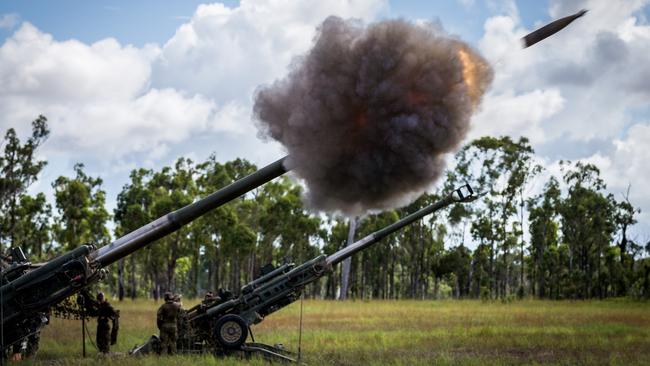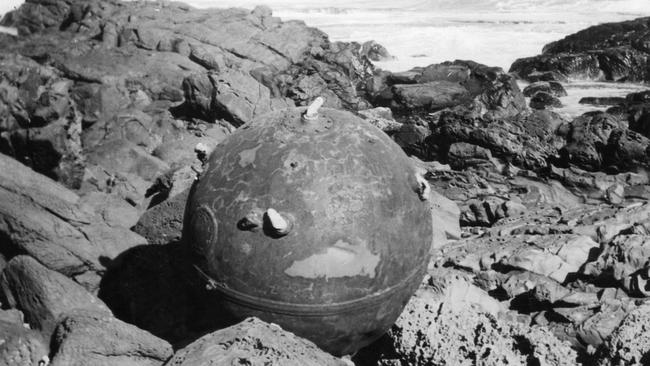$270bn military upgrade will bring more major projects to SA as Australia faces rising threat
A massive military strategy was unveiled on Wednesday, focusing on Australia’s increasing role in the Indo-Pacific. It’s likely to give SA billions of dollars and thosuands of jobs in technology and construction.
SA News
Don't miss out on the headlines from SA News. Followed categories will be added to My News.
- Defence shuts down Woomera waste dump suggestion
- Chinese official accuses Australia of ‘stealing information and data’
South Australia could secure a major slice of more than $40 billion worth of new shipbuilding projects and thousands of jobs as part of Scott Morrison’s plan to upgrade the nation’s defences.
The state could also play a crucial role in a $7 billion space defence plan to build an independent satellite network that will become “critical” to the ADF’s “war fighting effectiveness”.
Woomera will be upgraded as part of the $270 billion defence step-up, and will be vital for testing hypersonic technology and other new weapons systems.
Premier Steven Marshall has welcomed the 2020 defence strategy as “excellent news” for SA, with its focus on space, satellites, cyber capabilities and “massive” new shipbuilding program.
“South Australia is unequivocally the defence state and so this announcement means more jobs for SA in the future,” he said.
SA will get $2.6 billion worth of defence infrastructure’ upgrades to the Edinburgh Defence precinct in Adelaide, Woomera, the Cultana Training Area and Port Wakefield’s facility.
Mr Marshall also flagged SA could take part in developing Australia’s new underwater surveillance system, which Defence documents show would be worth up to $4.5 billion of work and could include drones and surface systems.
Adelaide’s Osborne shipyard had capacity to take on more work in addition to the 12 Attack Class submarines and nine Hunter Class frigates being built over the next two decades, he said. “Western Australia is more focused on the smaller vessels but many of the vessels identified in this new plan tend to suit the capabilities that we have in South Australia,” Mr Marshall said.
He said Osborne had “brand new shipbuilding facilities” and SA had the necessary workforce to deliver the new projects, which include up to eight new mine-hunter ships, two new resupply and sea lift vessels and the design work for a future destroyer beyond 2030, collectively worth about $13.4 billion.

Defence SA chief executive Richard Price predicted the mine-hunter ships would be nabbed by Western Australia, but expected South Australia would take on the two sea-lift ships and the destroyer design.
The state would also play a vital role in hypersonic missile tracking research, a $1 billion expansion of the Jindalee Operational Radar Network and could “capture a large slice” of $50 billion worth of joint projects on space, cyber and long range surveillance.
On the $7 billion space plan, Mr Marshall said: “We’re already building satellites for the Department of Defence, the CSIRO and the Space Agency on Lot Fourteen so this is extraordinarily positive news for the space sector in Australia and particularly the space sector in SA.”
In a major speech on Thursday, Defence Minister Linda Reynolds will say the $270 billion plan will produce a “far more potent ADF” and an “increasingly capable and vibrant sovereign Australian defence industry”. “This review found that our security environment has deteriorated far more rapidly and in ways we could not have predicted four years ago,” she will say.

Smart sea mines and laser beams
Energy weapons, more commonly known as lasers, will be mounted on ships and tanks as part of Australia’s “next generation” defence force.
Smart sea mines would be deployed tactically off the coast of Australia to prevent attacks by sea, with a defence analyst predicting they would be used off the coast of Adelaide.
Hypersonic weapons that can fly faster than the speed of sound – as well as technology to track hypersonic missiles – are also being investigated as part of the 2020 defence strategy.
A new underwater surveillance system is also being developed.
Peter Jennings, head of the Australian Strategic Policy Institute think tank, said Australia had the capacity to build the futuristic technology.
“We make a lot of sophisticated mining gear, we produce high quality medical technology so I think it’s within our ability to do pretty much any of that, so long as the funding is appropriate to make it happen,” he said.
Mr Jennings believed the Federal Government would need to inject much more than $270 billion.
But he said the smart sea mines in particular were a relatively low cost, high value defence which would make life difficult for any approaching adversary.

“You’d be using them for tactical purposes, they wouldn’t be staying out there all the time,” he said.
“You’d probably want to deploy them on approaches to ... Osborne in South Australia.”
Mr Jennings said the defence upgrade and pivot to the Indo-Pacific was “necessary” with China being more “assertive” and North Korea’s military modernisation. He said coronavirus had made the Government realise it couldn’t just focus on “building the perfect force for the second half of the 2030s and into 2040”.
“They’ve gone all out in this statement to increase the hitting power of the existing defence force and to do things in pretty short order; 12 months to 24 months to add more to the deterrent capability of the force,” he said.
The defence strategy highlights the need for Australia to be more self-sufficient in its defence manufacturing, particularly in the wake of COVID-19 disrupting global supply chains.
It flags the possibility of Australia developing industry to make its own munitions, including “guided weapons” and “explosive ordnance”.
State Labor leader Peter Malinauskas welcomed the defence strategy but said the State Government would need to fight to get a “fair share” of the work for SA.
$6 billion to keep Collins subs afloat
A contract worth up to $6 billion to keep the Collins Class submarines in the water until the 2040s will come up for grabs this year.
The 2020 Defence strategy confirms a life-of-type extension for the Collins could cost between $3.5 billion and $6 billion.

The work would extend the life of each sub for another 10 years, and would be done after full-cycle docking. The Federal Government is yet to make a decision on whether to keep the initial maintenance work in South Australia or move it to Western Australia.
But if the full-cycle docking work moves to Perth, the strategy shows the extent of the extra work SA could lose.
It’s understood the Government will make a decision on the life-of-type extension for the Collins Class in the next 12 months, including how many of the six subs to extend. The process would keep the subs in the water longer as the 12 Attack Class submarines come online.
A Defence spokeswoman on Wednesday confirmed a decision on “the future location” of full-cycle docking had not yet been made.
It’s among more than $40 billion worth of extra shipbuilding work that could be done in SA or WA.
